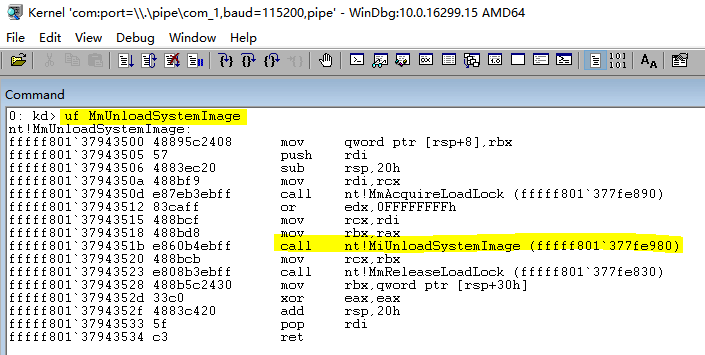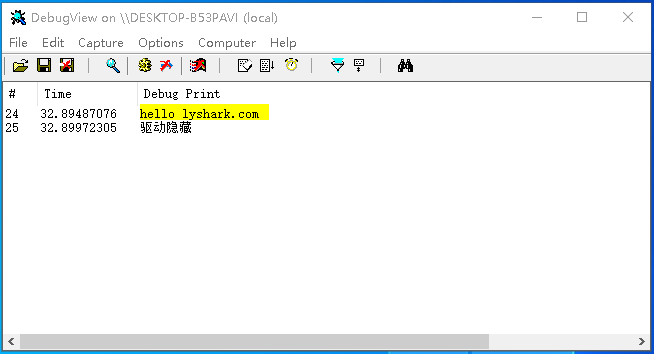在笔者前面有一篇文章《断链隐藏驱动程序自身》通过摘除驱动的链表实现了断链隐藏自身的目的,但此方法恢复时会触发PG会蓝屏,偶然间在网上找到了一个作者介绍的一种方法,觉得有必要详细分析一下他是如何实现的进程隐藏的,总体来说作者的思路是最终寻找到MiProcessLoaderEntry的入口地址,该函数的作用是将驱动信息加入链表和移除链表,运用这个函数即可动态处理驱动的添加和移除问题。
MiProcessLoaderEntry(pDriverObject->DriverSection, 1) 添加
MiProcessLoaderEntry(pDriverObject->DriverSection, 0) 移除
MiProcessLoaderEntry 是Windows内核中的一个结构体,用于描述系统中加载的进程信息。它通常被称为进程加载器入口(Process Loader Entry),是Windows内核中的一个重要数据结构。当一个新的进程被创建时,内核会为该进程分配一个进程对象(EPROCESS结构体),并为该进程加载相应的可执行文件。在加载可执行文件的过程中,内核会使用MiProcessLoaderEntry结构体来跟踪该进程的加载信息。
MiProcessLoaderEntry 结构体中包含了进程的各种加载信息,如可执行文件的路径、加载偏移量、加载基地址、入口点地址等。此外,它还包含了一些用于调试和安全的信息,如调试信息指针、保护标志等。
需要注意的是,MiProcessLoaderEntry结构体是一个内部结构体,不应该直接访问它。如果需要访问进程的加载信息,可以使用Windows内核提供的API函数,如ZwQueryInformationProcess和NtQueryInformationProcess等函数。
如何找到MiProcessLoaderEntry函数入口地址就是下一步的目标,寻找入口可以总结为;
1.寻找MmUnloadSystemImage函数地址,可通过MmGetSystemRoutineAddress函数得到。
2.在MmUnloadSystemImage里面寻找MiUnloadSystemImage函数地址。
3.在MiUnloadSystemImage里面继续寻找MiProcessLoaderEntry即可。
搜索MmUnloadSystemImage可定位到call nt!MiUnloadSystemImage地址。
搜索MiUnloadSystemImage定位到call nt!MiProcessLoaderEntry即得到了我们想要的。
根据前面枚举篇系列文章,定位这段特征很容易实现,如下是一段参考代码。
#include <ntddk.h> #include <ntstrsafe.h> typedef NTSTATUS (__fastcall *MiProcessLoaderEntry) (PVOID pDriverSection, BOOLEAN bLoad) ;PVOID GetProcAddress (WCHAR *FuncName) { UNICODE_STRING u_FuncName = { 0 }; PVOID ref = NULL ; RtlInitUnicodeString(&u_FuncName, FuncName); ref = MmGetSystemRoutineAddress(&u_FuncName); if (ref != NULL ) { return ref; } return ref; } ULONG64 GetMiUnloadSystemImageAddress () { CHAR MmUnloadSystemImage_Code[] = "\x83\xCA\xFF" "\x48\x8B\xCF" "\x48\x8B\xD8" "\xE8" ; ULONG_PTR MmUnloadSystemImageAddress = 0 ; ULONG_PTR MiUnloadSystemImageAddress = 0 ; ULONG_PTR StartAddress = 0 ; MmUnloadSystemImageAddress = (ULONG_PTR)GetProcAddress(L"MmUnloadSystemImage" ); if (MmUnloadSystemImageAddress == 0 ) { return 0 ; } StartAddress = MmUnloadSystemImageAddress; while (StartAddress < MmUnloadSystemImageAddress + 0x500 ) { if (memcmp ((VOID*)StartAddress, MmUnloadSystemImage_Code, strlen (MmUnloadSystemImage_Code)) == 0 ) { StartAddress += strlen (MmUnloadSystemImage_Code); MiUnloadSystemImageAddress = *(LONG*)StartAddress + StartAddress + 4 ; break ; } ++StartAddress; } if (MiUnloadSystemImageAddress != 0 ) { return MiUnloadSystemImageAddress; } return 0 ; } MiProcessLoaderEntry GetMiProcessLoaderEntry (ULONG64 StartAddress) { if (StartAddress == 0 ) { return NULL ; } while (StartAddress < StartAddress + 0x600 ) { if (*(UCHAR*)StartAddress == 0xE8 && *(UCHAR *)(StartAddress + 5 ) == 0x8B && *(UCHAR *)(StartAddress + 6 ) == 0x05 ) { StartAddress++; return (MiProcessLoaderEntry)(*(LONG*)StartAddress + StartAddress + 4 ); } ++StartAddress; } return NULL ; } VOID UnDriver (PDRIVER_OBJECT driver) { DbgPrint("卸载完成... \n" ); } NTSTATUS DriverEntry (IN PDRIVER_OBJECT Driver, PUNICODE_STRING RegistryPath) { DbgPrint("hello lyshark.com \n" ); ULONG64 MiUnloadSystemImageAddress = GetMiUnloadSystemImageAddress(); DbgPrint("MiUnloadSystemImageAddress = %p \n" , MiUnloadSystemImageAddress); MiProcessLoaderEntry MiProcessLoaderEntryAddress = GetMiProcessLoaderEntry(MiUnloadSystemImageAddress); DbgPrint("MiProcessLoaderEntryAddress = %p \n" , (ULONG64)MiProcessLoaderEntryAddress); Driver->DriverUnload = UnDriver; return STATUS_SUCCESS; }
运行驱动程序,即可得到MiProcessLoaderEntryAddress的内存地址。
得到内存地址之后,直接破坏掉自身驱动的入口地址等,即可实现隐藏自身。
#include <ntddk.h> #include <ntstrsafe.h> typedef NTSTATUS (*NTQUERYSYSTEMINFORMATION) ( IN ULONG SystemInformationClass, OUT PVOID SystemInformation, IN ULONG_PTR SystemInformationLength, OUT PULONG_PTR ReturnLength OPTIONAL) ;NTSYSAPI NTSTATUS NTAPI ObReferenceObjectByName ( __in PUNICODE_STRING ObjectName, __in ULONG Attributes, __in_opt PACCESS_STATE AccessState, __in_opt ACCESS_MASK DesiredAccess, __in POBJECT_TYPE ObjectType, __in KPROCESSOR_MODE AccessMode, __inout_opt PVOID ParseContext, __out PVOID* Object ) ;typedef struct _SYSTEM_MODULE_INFORMATION { HANDLE Section; PVOID MappedBase; PVOID Base; ULONG Size; ULONG Flags; USHORT LoadOrderIndex; USHORT InitOrderIndex; USHORT LoadCount; USHORT PathLength; CHAR ImageName[256 ]; } SYSTEM_MODULE_INFORMATION, *PSYSTEM_MODULE_INFORMATION; typedef struct _LDR_DATA_TABLE_ENTRY { LIST_ENTRY InLoadOrderLinks; LIST_ENTRY InMemoryOrderLinks; LIST_ENTRY InInitializationOrderLinks; PVOID DllBase; PVOID EntryPoint; }LDR_DATA_TABLE_ENTRY, *PLDR_DATA_TABLE_ENTRY; extern POBJECT_TYPE *IoDriverObjectType;typedef NTSTATUS (__fastcall *MiProcessLoaderEntry) (PVOID pDriverSection, BOOLEAN bLoad) ;ULONG64 MiUnloadSystemImageAddress = 0 ; PVOID GetProcAddress (WCHAR *FuncName) { UNICODE_STRING u_FuncName = { 0 }; PVOID ref = NULL ; RtlInitUnicodeString(&u_FuncName, FuncName); ref = MmGetSystemRoutineAddress(&u_FuncName); if (ref != NULL ) { return ref; } return ref; } ULONG64 GetMiUnloadSystemImageAddress () { CHAR MmUnloadSystemImage_Code[] = "\x83\xCA\xFF\x48\x8B\xCF\x48\x8B\xD8\xE8" ; ULONG_PTR MmUnloadSystemImageAddress = 0 ; ULONG_PTR MiUnloadSystemImageAddress = 0 ; ULONG_PTR StartAddress = 0 ; MmUnloadSystemImageAddress = (ULONG_PTR)GetProcAddress(L"MmUnloadSystemImage" ); if (MmUnloadSystemImageAddress == 0 ) { return 0 ; } StartAddress = MmUnloadSystemImageAddress; while (StartAddress < MmUnloadSystemImageAddress + 0x500 ) { if (memcmp ((VOID*)StartAddress, MmUnloadSystemImage_Code, strlen (MmUnloadSystemImage_Code)) == 0 ) { StartAddress += strlen (MmUnloadSystemImage_Code); MiUnloadSystemImageAddress = *(LONG*)StartAddress + StartAddress + 4 ; break ; } ++StartAddress; } if (MiUnloadSystemImageAddress != 0 ) { return MiUnloadSystemImageAddress; } return 0 ; } MiProcessLoaderEntry GetMiProcessLoaderEntry (ULONG64 StartAddress) { if (StartAddress == 0 ) { return NULL ; } while (StartAddress < StartAddress + 0x600 ) { if (*(UCHAR*)StartAddress == 0xE8 && *(UCHAR *)(StartAddress + 5 ) == 0x8B && *(UCHAR *)(StartAddress + 6 ) == 0x05 ) { StartAddress++; return (MiProcessLoaderEntry)(*(LONG*)StartAddress + StartAddress + 4 ); } ++StartAddress; } return NULL ; } BOOLEAN GetDriverObjectByName (PDRIVER_OBJECT *DriverObject, WCHAR *DriverName) { PDRIVER_OBJECT TempObject = NULL ; UNICODE_STRING u_DriverName = { 0 }; NTSTATUS Status = STATUS_UNSUCCESSFUL; RtlInitUnicodeString(&u_DriverName, DriverName); Status = ObReferenceObjectByName(&u_DriverName, OBJ_CASE_INSENSITIVE, NULL , 0 , *IoDriverObjectType, KernelMode, NULL , &TempObject); if (!NT_SUCCESS(Status)) { *DriverObject = NULL ; return FALSE; } *DriverObject = TempObject; return TRUE; } BOOLEAN SupportSEH (PDRIVER_OBJECT DriverObject) { PDRIVER_OBJECT Object = NULL ;; PLDR_DATA_TABLE_ENTRY LdrEntry = NULL ; GetDriverObjectByName(&Object, L"\\Driver\\tdx" ); if (Object == NULL ) { return FALSE; } LdrEntry = (PLDR_DATA_TABLE_ENTRY)DriverObject->DriverSection; LdrEntry->DllBase = Object->DriverStart; ObDereferenceObject(Object); return TRUE; } VOID InitInLoadOrderLinks (PLDR_DATA_TABLE_ENTRY LdrEntry) { InitializeListHead(&LdrEntry->InLoadOrderLinks); InitializeListHead(&LdrEntry->InMemoryOrderLinks); } VOID Reinitialize (PDRIVER_OBJECT DriverObject, PVOID Context, ULONG Count) { MiProcessLoaderEntry m_MiProcessLoaderEntry = NULL ; ULONG *p = NULL ; m_MiProcessLoaderEntry = GetMiProcessLoaderEntry(MiUnloadSystemImageAddress); if (m_MiProcessLoaderEntry == NULL ) { return ; } SupportSEH(DriverObject); m_MiProcessLoaderEntry(DriverObject->DriverSection, 0 ); InitInLoadOrderLinks((PLDR_DATA_TABLE_ENTRY)DriverObject->DriverSection); DriverObject->DriverSection = NULL ; DriverObject->DriverStart = NULL ; DriverObject->DriverSize = 0 ; DriverObject->DriverUnload = NULL ; DriverObject->DriverInit = NULL ; DriverObject->DeviceObject = NULL ; DbgPrint("驱动隐藏 \n" ); } VOID UnDriver (PDRIVER_OBJECT driver) { DbgPrint("卸载完成... \n" ); } NTSTATUS DriverEntry (IN PDRIVER_OBJECT Driver, PUNICODE_STRING RegistryPath) { DbgPrint("hello lyshark.com \n" ); MiUnloadSystemImageAddress = GetMiUnloadSystemImageAddress(); MiProcessLoaderEntry MiProcessLoaderEntryAddress = GetMiProcessLoaderEntry(MiUnloadSystemImageAddress); IoRegisterDriverReinitialization(Driver, Reinitialize, NULL ); Driver->DriverUnload = UnDriver; return STATUS_SUCCESS; }
运行驱动程序,让后看到如下输出信息;



